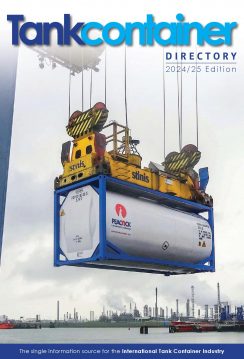Tankcontainer Magazine reports on an innovative programme of research into the temperature behaviour of liquid cargoes in tank containers, initiated by HOYER
The incidences of catastrophic rupture and explosion are mercifully few in the half-century history of the tank container industry. This generally excellent record is a key driver behind the continued adoption of tank containers as a safe, reliable, convenient and flexible means of moving often hazardous liquid chemicals around the globe.
The behaviour of the liquids carried by tank containers is obviously an integral part of the overall safety characteristic of any laden tank container. Research into the in-situ fluid dynamics of cargoes within tank containers has led to a greater understanding of, for instance, cargo surge. This has resulted in better insights into baffle design and loading limits, leading to uprated guidance for those involved in the transportation of tank containers.
How liquid cargoes react under different temperature regimes is another essential area to understand for tank container players, and an intimate knowledge of this becomes critically important when handling hazardous liquids.
Safety Data Sheets (or Material Safety Data Sheets) map out the mandatory, or advised, requirements for the movement of a particular product but some chemicals are more temperature sensitive than others - isocyanates, for example, are one of the most common chemicals moved in tank containers but have very specific temperature-related requirements. Guidance from ISOPA, the
To read the rest of this feature please visit https://www.tankcontainermedia.com/subscribe/
December 14, 2020
The incidences of catastrophic rupture and explosion are mercifully few in the half-century history of the tank container industry. This generally excellent record is a key driver behind the continued adoption of tank containers as a safe, reliable, convenient and flexible means of moving often hazardous liquid chemicals around the globe.
The behaviour of the liquids carried by tank containers is obviously an integral part of the overall safety characteristic of any laden tank container. Research into the in-situ fluid dynamics of cargoes within tank containers has led to a greater understanding of, for instance, cargo surge. This has resulted in better insights into baffle design and loading limits, leading to uprated guidance for those involved in the transportation of tank containers.
How liquid cargoes react under different temperature regimes is another essential area to understand for tank container players, and an intimate knowledge of this becomes critically important when handling hazardous liquids.
Safety Data Sheets (or Material Safety Data Sheets) map out the mandatory, or advised, requirements for the movement of a particular product but some chemicals are more temperature sensitive than others - isocyanates, for example, are one of the most common chemicals moved in tank containers but have very specific temperature-related requirements. Guidance from ISOPA, the
To read the rest of this feature please visit https://www.tankcontainermedia.com/subscribe/
December 14, 2020
You currently do not have access to this article, please login or register to read more.
Login to read more






